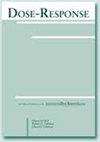Potential Radiological Problems in the Ukrainian War Zone and Challenges for Related Health Risks Assessments
IF 2.3
4区 医学
Q3 PHARMACOLOGY & PHARMACY
引用次数: 0
Abstract
The seriously damaged Chernobyl nuclear power plant is located in the Ukrainian war zone. Intentional or accidental release via detonation of radionuclides from the plant site could pose serious health risks to the nearby population. Cancers in different organs are the main risk of concern for low radiation doses; however, the manner of assessing cancer risks is now controversial in that the linear-nothreshold (LNT) model used by epidemiologists (e.g., ) contradicts current knowledge of the chemico-biological interactions that occur in the body after low radiation doses and also promotes radiation phobia. Which other model to use is unclear. The previous Low Dose Radiation Research Program in the United States that partly focused on radiobiological research that was linked to improving health-risk-assessment approaches was unfortunately canceled about 10 years ago. In establishing an approach to use in addressing health risks for low radiation doses to humans, researchers need to take into consideration that unlike animal-studies data, epidemiologic-studies data for humans are very noisy (wider stochastic error distributions) 5 so that any risk estimates generated using such data likely involve large errors. Animal-studies data with smaller errors (for radiation doses and biological effects) than epidemiologic-studies data could be used in improving modeling methods employed in epidemiologic studies and in testing reliability of cancer risk predictions for low radiation doses. Regarding the risks of specific life-threatening deterministic effects of large radiation doses (unlikely to occur for most individuals in the Ukrainian war zone), the acute lethality and morbidity risks can be approximated using endpoint-specific, nonlinear, hazard-function (HF) models. These models feature dose and dose-rate-related thresholds and allow for external exposure to gamma radiation in combination with internal exposure via alphaparticle-, beta-particle-, and gamma-ray-emitting radionuclides. The HF models also address the complex doserate patterns that are associated with internal radionuclides and can be implemented using existing computer code systems developed in the United States and in Europe for assessing expected health consequences of nuclear power plant accidents for given populations; however, parameters for the endpoint-specific HF models were estimated using deficient data that were available at the time the models were developed (i.e., prior to 1995). Thus, parameters for endpoint-specific HF models need to be updated using now-available data and the updated parameter estimates (and related uncertainties) need to be incorporated into computer codes used in assessing risks (and related uncertainties) of radiation deterministic health effects that include specific morbidity types and lethality modes.乌克兰战区潜在的辐射问题和相关健康风险评估的挑战
受损严重的切尔诺贝利核电站位于乌克兰战区。核电站现场放射性核素的故意或意外爆炸释放可能会对附近人群造成严重的健康风险。不同器官的癌症是低辐射剂量引起关注的主要风险;然而,评估癌症风险的方式现在是有争议的,因为流行病学家使用的线性-非整形(LNT)模型(例如)与目前对低辐射剂量后体内发生的化学-生物相互作用的认识相矛盾,也会促进辐射恐惧症。目前还不清楚该使用哪种型号。美国以前的低剂量辐射研究计划部分专注于与改进健康风险评估方法有关的放射生物学研究,但不幸的是,该计划在大约10年前被取消。在建立一种用于解决低辐射剂量对人类健康风险的方法时,研究人员需要考虑到,与动物研究数据不同,人类的流行病学研究数据非常嘈杂(更广泛的随机误差分布)5,因此使用这些数据产生的任何风险估计都可能涉及大误差。与流行病学研究数据相比,具有较小误差(辐射剂量和生物效应)的动物研究数据可用于改进流行病学研究中使用的建模方法,并用于测试低辐射剂量癌症风险预测的可靠性。关于大剂量辐射的特定威胁生命的决定性影响的风险(乌克兰战区的大多数人不太可能发生),可以使用终点特定的非线性危险函数(HF)模型来近似急性致死和发病风险。这些模型具有剂量和剂量率相关阈值,并允许外部暴露于伽马辐射,同时通过α粒子、β粒子和伽马射线发射放射性核素进行内部暴露。HF模型还涉及与内部放射性核素相关的复杂剂量率模式,可以使用美国和欧洲开发的现有计算机代码系统来实施,以评估核电站事故对特定人群的预期健康后果;然而,使用开发模型时(即1995年之前)可用的不足数据来估计终点特异性HF模型的参数。因此,需要使用现在可用的数据更新终点特异性HF模型的参数,并且需要将更新的参数估计(和相关的不确定性)纳入用于评估辐射确定性健康影响的风险(和相关不确定性)的计算机代码中,辐射确定性健康效应包括特定的发病率类型和致死模式。
本文章由计算机程序翻译,如有差异,请以英文原文为准。
求助全文
约1分钟内获得全文
求助全文
来源期刊

Dose-Response
PHARMACOLOGY & PHARMACY-RADIOLOGY, NUCLEAR MEDICINE & MEDICAL IMAGING
CiteScore
4.90
自引率
4.00%
发文量
140
审稿时长
>12 weeks
期刊介绍:
Dose-Response is an open access peer-reviewed online journal publishing original findings and commentaries on the occurrence of dose-response relationships across a broad range of disciplines. Particular interest focuses on experimental evidence providing mechanistic understanding of nonlinear dose-response relationships.
 求助内容:
求助内容: 应助结果提醒方式:
应助结果提醒方式:


